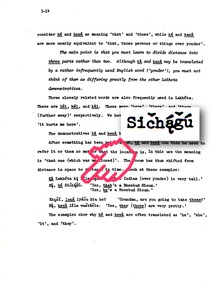Sicangu

 Janeen Antoine (Sičhą́ǧu Lakóta), curator and educator[1] | |
| Regions with significant populations | |
|---|---|
| United States (South Dakota) | |
| Languages | |
| Lakȟóta, English | |
| Religion | |
| traditional tribal religion, Sun Dance, Native American Church, Christianity | |
| Related ethnic groups | |
| other Lakȟóta people |
The Sicangu are one of the seven oyates, nations or council fires, of Lakota people,[2] an Indigenous people of the Northern Plains. Today, many Sicangu people are enrolled citizens of the Rosebud Sioux Tribe of the Rosebud Indian Reservation and Lower Brule Sioux Tribe of the Lower Brule Reservation in South Dakota.
Distribution
[edit]Many Sičhą́ǧu people live on the Rosebud Indian Reservation in southwestern South Dakota and are enrolled in the federally recognized Rosebud Sioux Tribe, also known in Lakȟóta as the Sičhą́ǧu Oyáte. A smaller population lives on the Lower Brule Indian Reservation, on the west bank of the Missouri River in central South Dakota, and on the Pine Ridge Indian Reservation, also in South Dakota, directly west of the Rosebud Indian Reservation. The different federally recognized tribes are politically independent of each other.
Name
[edit]The Sicangu Lakota are known as Sičhą́ǧu Oyáte in Lakȟóta, which translates to "Burnt Thighs Nation". Learning the meaning of their name, the French called them the Brûlé, also Brulé, meaning "burnt". The name may have derived from an incident where they were fleeing through a grass fire on the plains.

The term "Sičhą́ǧu" appears on pages 3 to 14 of Beginning Lakhóta.[3]
"Ká Lakȟóta kį líla hą́ske. 'That Indian (over yonder) is very tall.'"
"Hą, hé Sičhą́ǧú. 'Yes, that's a Rosebud Sioux.'"
It appears to be a compound word of the Thítȟųwą Lakȟóta dialect, meaning "burned thigh".[4]
Historic Sicangu Thiyóšpaye or bands
[edit]Together with the Oglála Lakȟóta, who are mostly based at the Pine Ridge Indian Reservation, they are often called Southern Lakȟóta.
They were divided in three great regional tribal divisions:
- Lower Brulé (Khúl Wičháša Oyáte, "Lowland People", lived along the White River to its mouth at the Missouri River (Mnišóše) as well in the Missouri River Valley in South Dakota; some ventured south to the Niobrara River).[5]
- Upper Brulé (Ȟeyáta Wičháša Oyáte - ″Highland People″, ventured further south and west onto the Plains along the Platte River between the North and South Platte River in Nebraska in the search for buffalo. The allied Southern Cheyenne and Southern Arapaho welcomed them as strong allies to this lands which they had further claimed, along the Loup River - the former center of the Skidi Pawnee. They went south to plunder enemy Pawnee and Arikara camps, and were therefore also known as: Kheyatawhichasha - ″People away from the (Missouri) River″)
- (Upper) Brulé of the Platte River (a splinter group of the Upper Brulé and the southernmost Sicangu group, generally along the South Platte River in Colorado, with hunting bands south to the Republican River - home to the enemy Kithehaki / Kitkehaxki of the South Bands Pawnee, also known as: Kheyatawhichasha - ″People away from the (Missouri) River″)
According to the Kul Wicasa (Lower Brule) Medicine Bull (Tatȟą́ka Wakȟą́), the people were decentralized and identified with the following thiyóšpaye, or extended family groups, who collected in various local thiwáhe (English: camps or family circles):
- Apewantanka
- Chokatowela
- Ihanktonwan
- Iyakoza[7]
- Kanghi yuha
- Nakhpakhpa
- Pispiza wichasha
- Shawala
- Shiyolanka
- Wacheunpa
- Waleghaunwohan
Ethnobotany
[edit]The Sicangu give pulverized roots of green comet milkweed (Asclepias viridiflora) to children with diarrhea. Nursing mothers take an infusion of the whole plant to increase their milk flow.[8] They brew the leaves of prairie redroot (Ceanothus herbaceus) into a tea.[9]
Notable Sicangu
[edit]
- Bob Barker Game Show Host
- Pappy Boyington, WWII Marine Corps fighter ace and Medal of Honor recipient
- Mary Brave Bird, author
- Leonard Crow Dog, spiritual leader, American Indian Movement activist
- Paul Eagle Star (1866-24 August 1891), performer with Buffalo Bill's Wild West Show
- Hollow Horn Bear, chief
- Iron Nation, chief
- Iron Shell, chief
- Little Thunder, chief
- Arnold Short Bull, a well-known Sicangu holy man, who brought the Ghost Dance to the Lakota in South Dakota in 1890
- Lone Feather, Republican public administrator from South Dakota, first Lakota elected to the U.S. House of Representatives
- Michael Spears, actor
- Eddie Spears, actor
- Spotted Tail or "Sinte Gleska", 19th-century chief[10]
- Nellie Star Boy Menard, quiltmaker
- Moses Stranger Horse, artist
- Two Strike, chief
- Albert White Hat, Lakota language teacher
- Dyani White Hawk, contemporary painter and former curator of All My Relations Arts gallery
- Rosebud Yellow Robe, folklorist, educator and author
- Frank Waln, rapper
See also
[edit]References
[edit]- ^ "Native American Heritage Month: S.F. gallery director wins praise for breaking with past."[permanent dead link] San Francisco Chronicle. 12 Nov 1995 (retrieved 20 Dec 2009)
- ^ Howe, Craig; Katz, Abe (Spring 2015). "Traditional Lakota Governance". Rootstalk. Center for Prairie Studies. Retrieved 23 June 2024.
- ^ Beginning Lakhóta, Volume 1 (Boulder: University of Colorado Lakhóta Project, 1976).
- ^ Famous Indians of Northwest Nebraska. Chadron Centennial Committee. 1983. p. 34.
- ^ "Lower Brule". Archived from the original on 2015-05-02. Retrieved 2010-02-06.
- ^ Clark, Patricia Roberts (21 October 2009). Tribal Names of the Americas: Spelling Variants and Alternative Forms, Cross-Referenced. McFarland. p. 10. ISBN 978-0-7864-5169-2.
- ^ Also spelled A-a-ko-za or Aakoza.[6]
- ^ Rogers, Dilwyn J, 1980, Lakota Names and Traditional Uses of Native Plants by Sicangu (Brule) People in the Rosebud Area, South Dakota, St. Francis, SD. Rosebud Educational Society, page 34
- ^ Rogers, Dilwyn J., 1980, Lakota Names and Traditional Uses of Native Plants by Sicangu (Brule) People in the Rosebud Area, South Dakota, St. Francis, SD. Rosebud Educational Society, page 56
- ^ Brown, Dee (1970). Bury My Heart at Wounded Knee, ch. 6. Bantam Books. ISBN 0-553-11979-6.